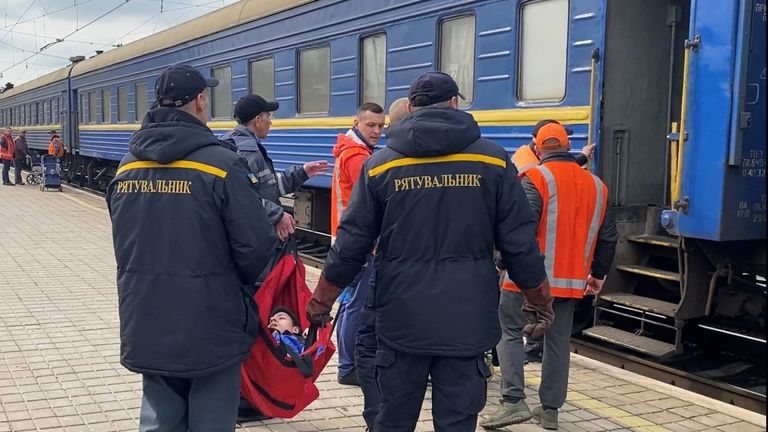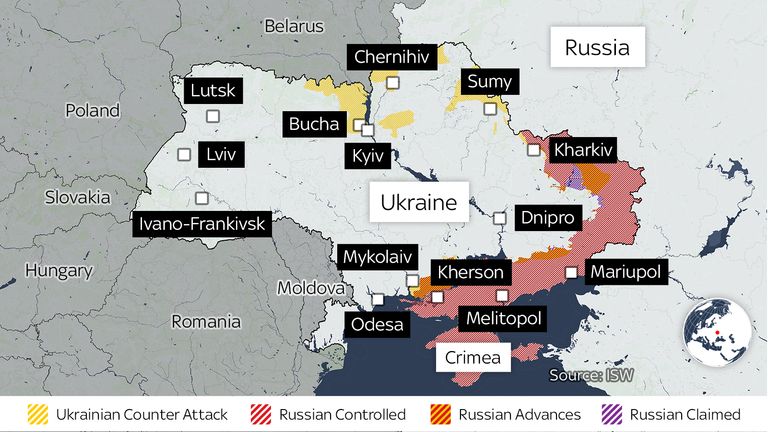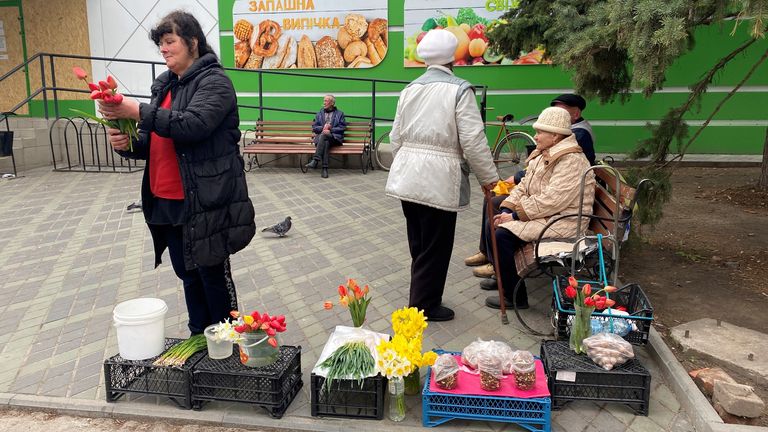We’d only been out with the police for a few minutes.
The thud was distant. But close enough to abort the patrol.
“Turn around, turn around…” Lieutenant Colonel Sasha Malysh said. “It’s shelling.”
Then the police radio crackled.
“Attention to all patrols… go to the shelter.”
Pope condemns ‘Easter of war’ as Kharkiv hit by heavy shelling’ – Ukraine war live updates
The police in Kramatorsk abandoned their headquarters weeks ago. It’s a Russian target.
And so the drive, at speed, was back to their makeshift base, and a makeshift bomb shelter at a location they didn’t want us to reveal.
The second impact seemed closer. A loud boom. It’s a daily threat here in this town in the Donbas region in eastern Ukraine.
“It was less than one kilometre from us,” Colonel Malysh said.
It’s from the bomb shelter that they deal with multiple challenges.
These officers were the first responders to the attack at the train station here just over a week ago. More than 50 people – mostly women and children – died.
But it’s more than the Russian shells. They look for saboteurs who are in this town and are believed to be sending images of potential targets to the Russian forces on the other side.
After 15 minutes, the all-clear came and we could resume the patrol.
Colonel Malysh is just 29-years-old and he’s in charge of the patrols here and in the neighbouring city.
We passed an apartment block that was destroyed in one of the attacks. A bomb or a missile from a plane, the colonel told us. At least three people died. It’s a wonder it wasn’t many more.
The train station is in the centre of a city that now only has half its population. The rest have left.
The station was the evacuation point, but not anymore; not since the mayhem here.
“It was horrible. People were lying without hands and legs. Everyone was crying for help. We were trying to bandage them,” one of the colonel’s even younger officers told me.
Read more: The young people who lost loved ones and limbs in Kramatorsk train station bombing
There are moments to be thankful though. We visited a kindergarten that was hit. But the children were not inside at the time.
Of course, with every building hit, so many damaged are probably reparable, but who knows when.
Our journey took us north out of Kramatorsk. We passed the signs of the battle beyond broken vehicles towed back, fuel tankers heading forward.
The city of Slovyansk, 25 minutes north of Kramatorsk, is a symbolic prize for Russia. It was the first place they captured in the 2014 war. This time it’s proving harder.
Most of those who lived here have left. But some remain. And outside the shuttered supermarket we met the flower sellers of Slovyansk.
“Many left the city,” one told me. “I have nowhere to go. I won’t go. This is my land and my country.”
A man next to her said: “Russia and Ukraine were brothers. Now they are fighting. I don’t understand why. I never thought Putin would do something like this.”
Then, for the fifth time since sunrise, the siren sounded again.
It forced our meeting with the mayor down into the shelter underneath the city’s old Soviet administrative HQ.
“I’m worried about what might happen,” Mayor Vadim Lyakh told me.
“We are preparing for all scenarios because we see what happened in Mariupol and other cities. Most people left here are elder people or those who have chronic diseases,” he said.
Pokrovsk, 60 miles away, is now the closest place from where people can get a train out.
And there, on platform one, we saw the cruelty of this war.
The 4.30 to the safety of Lviv in the west was a train full of the most vulnerable: the disabled and mentally ill. Some were in wheelchairs; some carried on blankets.
The price of one man’s war.





